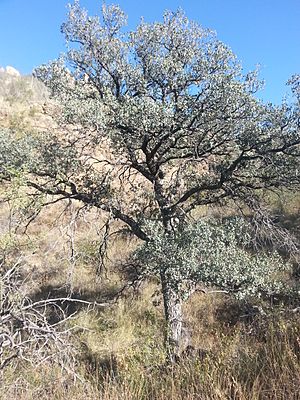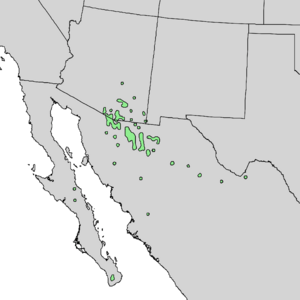Mexican blue oak facts for kids
Quick facts for kids Arizona blue oak |
|
|---|---|
 |
|
 |
|
| Conservation status | |
| Scientific classification | |
| Genus: |
Quercus
|
| Species: |
oblongifolia
|
 |
|
| Natural range of Quercus oblongifolia | |
The Arizona blue oak (also called Blue live oak or Sonoran blue oak) is a special kind of evergreen tree. This means it keeps its leaves all year round. It belongs to the white oak group. It can grow as a small tree or a large shrub.
Contents
Where the Arizona Blue Oak Grows
The Arizona blue oak is found in several places. It grows in high grasslands, deep canyons, and flat-topped mesas. You can find it in Texas, Arizona, and New Mexico in the United States. It also grows in northwestern Mexico, including states like Baja California Sur, Chihuahua, Coahuila, Sinaloa, and Sonora.
This tree is very similar to the Engelman oak, which grows in Southern California. Some scientists even think they might be the same species.
What the Arizona Blue Oak Looks Like
The Arizona blue oak is usually a small evergreen tree. It can grow about 5 to 8 meters (16 to 27 feet) tall. It often has a rounded shape at the top. If it grows in higher, colder places, it might look more like a large bush.
Its trunk can be up to 50 centimeters (20 inches) wide. The bark is light gray and has many deep grooves. The smaller branches, called twigs, are yellowish-brown and smooth. They have reddish-brown buds.
Leaves and Flowers
The leaves of the Arizona blue oak are small and grow one after another along the stem. They are shaped like an oval and have smooth edges. The top side of the leaf is a pretty bluish-green. The bottom side is a lighter green. The leaves feel a bit tough and leathery.
In the spring, new leaves start to grow. At the same time, the old leaves fall off. This is also when the flowers appear. The male flowers look like yellowish-green strings, called catkins. The female flowers are tiny and grow alone or in pairs where the leaves meet the stem.
Acorns
After the flowers, the tree produces light brown acorns. These acorns are oval-shaped and about 2 centimeters (0.8 inches) long. They sit in a scaly, bowl-shaped cup. This cup covers about one-third of the acorn.
Where the Arizona Blue Oak Lives
The Arizona blue oak is very common at certain heights. It likes to grow at elevations from 1200 to 1800 meters (4000 to 6000 feet) above sea level. It often grows in thin, sandy soils in areas that are quite dry.
It is a very important tree in open oak woodlands. Here, it often grows with other oak trees. These include the Arizona white oak (Quercus arizonica) and the Emory oak (Quercus emoryi).
The Arizona blue oak is also a key part of pinyon-juniper forests. In these areas, it grows alongside different types of pine and juniper trees. Other plants found with it include Arizona rosewood (Vauquelinia californica), shrubby buckwheat (Eriogonum wrightii), catclaw mimosa (Mimosa aculeaticarpa), and different grasses like bullgrass (Muhlenbergia emersleyi) and plains lovegrass (Eragrostis intermedia). You might also see fendlerbush (Fendlera rupicola) and wolftail (Lycurus phleoides).
Growing Arizona Blue Oaks
People are starting to plant the Arizona blue oak more often in gardens and parks. It has become popular in California, with many planted at places like Apple Park. This tree grows quickly and has beautiful blue-green leaves. Trees from Arizona are often chosen for planting because they grow best in new places.
See also
 In Spanish: Quercus oblongifolia para niños
In Spanish: Quercus oblongifolia para niños


